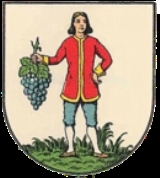
Grinzing
Encyclopedia
| Grinzing | |
|---|---|
| Coat of arms | Map |
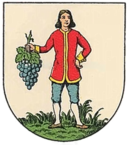 |
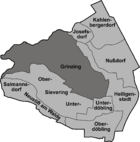 |
Location: 48°15′18"N 16°21′30"E |
|
Grinzing was an independent municipality
Municipality
A municipality is essentially an urban administrative division having corporate status and usually powers of self-government. It can also be used to mean the governing body of a municipality. A municipality is a general-purpose administrative subdivision, as opposed to a special-purpose district...
until 1892 and is today a part of Döbling
Döbling
Döbling is the 19th District in the city of Vienna, Austria . It is located on the north end from the central districts, north of the districts Alsergrund and Währing...
, the 19th district of Vienna.
Geography
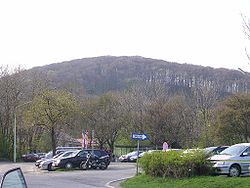
Location
Grinzing lies in the northwest of Vienna and, with an area of 613.52 hectares, is the largest suburb in the district of Döbling. To the northeast, it borders on JosefsdorfJosefsdorf
Josefsdorf was an independent municipality until 1892 and is today a part of Döbling, the 19th district of Vienna. It is also one of the 89 Katastralgemeinden.- Geography :...
; the border continues along the Wildgrube and the Schreiberbach stream towards the east, where it branches along the Springsiedelgasse and the Neugebauerweg to the south. The border then runs along the Hungerbergstraße to mark the boundary to Unterdöbling
Unterdöbling
Unterdöbling was an independent municipality until 1892 and is today a part of Döbling, the 19th district of Vienna. It is also one of the 89 Katastralgemeinden.- Geography :...
, before following the course of the Kaasgraben, which divides Grinzing from Sievering
Sievering
Sievering is a suburb of Vienna and part of Döbling, the 19th district of Vienna. Sievering was created in 1892 out of the two erstwhile independent suburbs Untersievering and Obersievering. These still exist as Katastralgemeinden.- Geography :...
in the east. Finally, the border turns northwestward and continues via the Himmelstraße and the Spießweg to the edge of the city of Vienna, which separates Grinzing from Weidling.
Topography
Grinzing is characterised by numerous forested ridges of the WienerwaldWienerwald
The Vienna Woods are forested highlands that form the northeastern foothills of the Northern Limestone Alps in the states of Lower Austria and Vienna. The long and wide hill range is heavily wooded and a popular recreation area with the Viennese....
(Vienna Woods). Hermannskogel
Hermannskogel
The Hermannskogel is a hill in Vienna. At 542 metres above sea level, it is the highest natural point in the city of Vienna. It lies on the border to Lower Austria....
, the tallest hill in Vienna, lies on the border to Lower Austria
Lower Austria
Lower Austria is the northeasternmost state of the nine states in Austria. The capital of Lower Austria since 1986 is Sankt Pölten, the most recently designated capital town in Austria. The capital of Lower Austria had formerly been Vienna, even though Vienna is not officially part of Lower Austria...
. There are also other well-known hills, including the Reisenberg
Reisenberg
Reisenberg is a town in the district of Baden in Lower Austria in Austria....
, Latisberg, Vogelsangberg, Hungerberg, and Pfaffenberg. Grinzing’s woods are home to several streams, including the Schreiberbach, which runs untouched through the Wildgrube almost as far as Nußdorf
Nußdorf, Vienna
Nußdorf was a separate municipality until 1892 and is today a suburb of Vienna in the 19th district of Döbling.- Location :Nußdorf lies on both banks of the Nußbach , where the brook meets the Danube Canal...
. The Reisenbergbach begins to the west of the Reisenberg and makes its way through Grinzing, where it flows into a canal. The headwaters of the Arbesbach also lie in the west of Grinzing. A further notable characteristic of the area are the grapevines, most notably the ones on Reisenberg and Hungerberg hills.
The origin of the name Grinzing
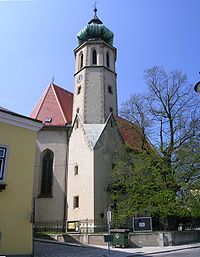
Sippe
Sippe is German for "clan, kindred, extended family". It continues a Proto-Germanic term *sibbja, which referred to a band or confederation bound by a treaty or oath, not primarily restricted to blood relations. The original character of sibb as a peace treaty is visible in Old English, e.g. in...
. A version of the name "Grinzing" first appears in 1114, when it was called Grinzigan.
Grinzing in the Middle Ages
The village of Grinzing came into the possession of the noble house Grunzinger in the 11th century. The Grunzinger built the Trummelhof, the remains of which can still be seen in the house at number 30 in the Cobenzlgasse. This former manor was supposedly thus named (Trümmer = rubble, Hof = court, yard) because it was built on top of Roman ruins.The village was inhabited primarily by vintner
Vintner
A vintner is a wine merchant. You pronounce it like this In some modern use, in particular in American English, the term is alsoused as a synonym for winemaker....
s and day labourers, who served land-owning monasteries and rich members of Vienna’s bourgeoisie. In the 14th century, the last of the Grunzinger, Rüdiger von Gründsing, died, and in 1350 he was buried in the Minoritenkirche
Minoritenkirche, Vienna
The Minoritenkirche, formal name: Italienische Nationalkirche Maria Schnee is a church built in French Gothic style in the Altstadt or First District of Vienna, Austria.The site on which the church is built was given to followers of Francis of Assisi in 1224...
in Vienna. Thereafter, Grinzing fell within the jurisdiction of the Klosterneuburg Monastery, which retained its authority over the area into the 19th century. The church "Zum heiligen Kreuz" (The Holy Cross) was erected in 1426.
Grinzing since the Middle Ages

Matthias Corvinus of Hungary
Matthias Corvinus , also called the Just in folk tales, was King of Hungary and Croatia from 1458, at the age of 14 until his death...
laid waste to the village, while in 1529 the Ottoman Turks
Ottoman wars in Europe
The wars of the Ottoman Empire in Europe are also sometimes referred to as the Ottoman Wars or as Turkish Wars, particularly in older, European texts.- Rise :...
inflicted heavy damage. In 1604, a major fire destroyed sections of the village and in 1683 the Turks once again ruined the newly-reconstructed houses. Grinzing nonetheless developed better than its neighbours. In 1713, there were 70 houses, but the plague hit the village hard. More than half of these houses were infected, and 129 people died. This seriously stunted the village’s growth.
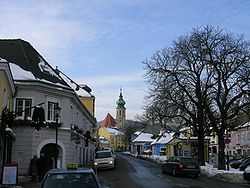
Joseph II, Holy Roman Emperor
Joseph II was Holy Roman Emperor from 1765 to 1790 and ruler of the Habsburg lands from 1780 to 1790. He was the eldest son of Empress Maria Theresa and her husband, Francis I...
. The village nonetheless developed only slowly in the following decades. In 1795, there were 83 houses. In 1822 there were 99 houses but there were no further additions until 1835. In 1831, Grinzing numbered 99 houses with 835 inhabitants and was thus barely larger than it had been in 1795. Thereafter, the rate of growth increased and the population had grown to 1,421 people in 209 houses by 1890.
In 1892, Grinzing was integrated into the city of Vienna. The area as far as the Wienerwald ridge was included along with Oberdöbling
Oberdöbling
Oberdöbling was an independent municipality until 1892 and is today a part of Döbling, the 19th district of Vienna. It is also one of the 89 Katastralgemeinden.- Geography :...
, Unterdöbling
Unterdöbling
Unterdöbling was an independent municipality until 1892 and is today a part of Döbling, the 19th district of Vienna. It is also one of the 89 Katastralgemeinden.- Geography :...
, Kahlenbergerdorf
Kahlenbergerdorf
Kahlenbergerdorf was an independent municipality until 1892 and is today a part of Döbling, the 19th district of Vienna. It is also one of the 89 Katastralgemeinden.- Location :...
, Nußdorf
Nußdorf, Vienna
Nußdorf was a separate municipality until 1892 and is today a suburb of Vienna in the 19th district of Döbling.- Location :Nußdorf lies on both banks of the Nußbach , where the brook meets the Danube Canal...
, Heiligenstadt
Heiligenstadt, Vienna
Heiligenstadt was an independent municipality until 1892 and is today a part of Döbling, the 19th district of Vienna.Heiligenstadt is one of the 10 municipalities in the Döbling District.- Geography :...
, Sievering
Sievering
Sievering is a suburb of Vienna and part of Döbling, the 19th district of Vienna. Sievering was created in 1892 out of the two erstwhile independent suburbs Untersievering and Obersievering. These still exist as Katastralgemeinden.- Geography :...
and Josefsdorf
Josefsdorf
Josefsdorf was an independent municipality until 1892 and is today a part of Döbling, the 19th district of Vienna. It is also one of the 89 Katastralgemeinden.- Geography :...
in the 19th district, Döbling
Döbling
Döbling is the 19th District in the city of Vienna, Austria . It is located on the north end from the central districts, north of the districts Alsergrund and Währing...
, while the rest of Grinzing was allocated to Weidling.
Grinzing’s reputation is based to this day on its viticulture and numerous Heurige, which are popular with tourists. Because of its popularity amongst package tour operators and the decline of professional vintners, Grinzing is less attractive for the Viennese. In order to restore the area’s attractiveness, the local Green party organised a competition to find ideas how the quality of life in Grinzing can be increased through a reduction in traffic.
Economy
The distribution of available land in Grinzing in 1826 makes it possible to guess at the important role that viticulture and logging played in the local economy. 45 percent of the land was covered in woods, which belonged to the Klosterneuburg Monastery. Another 23 percent were used for vineyards, while agriculture only played a secondary role, covering barely 10 percent of the land. Beer production also had a certain importance at times; in 1814, a brewery was founded in the Trummelhof that operated intermittently until 1831.Sights
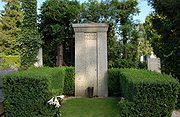
Kaasgrabenkirche
The Kaasgrabenkirche, also known as the Wallfahrtskirche “Mariä Schmerzen”, is a Roman Catholic parish and pilgrimage church in the suburb of Grinzing in the 19th district of Vienna, Döbling. The church has been managed since 1903 by the order of the Oblates of St. Francis de Sales and is equally...
are worth seeing. The large area covered by the Wienerwald is home to the Habsburgwarte
Habsburgwarte
The Habsburgwarte is a 27 metre-tall tower that stands on Hermannskogel hill in Vienna. It was built by architect Franz von Neumann to resemble a medieval tower....
on the Hermannskogel
Hermannskogel
The Hermannskogel is a hill in Vienna. At 542 metres above sea level, it is the highest natural point in the city of Vienna. It lies on the border to Lower Austria....
hill as well as a monument to Karl Lueger
Karl Lueger
Karl Lueger was an Austrian politician and mayor of Vienna. The populist and anti-Semitic politics of his Christian Social Party are sometimes viewed as a model for Hitler's Nazism.- Career :...
and the “Cobenzl” restaurant on the Reisenberg hill.
The graves of Gustav Mahler
Gustav Mahler
Gustav Mahler was a late-Romantic Austrian composer and one of the leading conductors of his generation. He was born in the village of Kalischt, Bohemia, in what was then Austria-Hungary, now Kaliště in the Czech Republic...
, Alma Mahler-Werfel, Attila Hörbiger
Attila Hörbiger
Attila Hörbiger was an Austrian stage and movie actor.Hörbiger was born in Budapest, then Austria–Hungary, the son of engineer Hanns Hörbiger and younger brother of actor Paul Hörbiger...
, Paula Wessely
Paula Wessely
Paula Anna Maria Wessely was an Austrian theatre and film actress. Die Wessely , as she was affectionately called by her admirers and fans, was Austria's foremost popular postwar actress....
, Heimito von Doderer
Heimito von Doderer
Heimito von Doderer was a famous Austrian writer.- Life and work :...
, Ida Krottendorf
Ida Krottendorf
Ida Krottendorf was an Austrian actress. She was married from 1955 to Austrian actor Ernst Stankovski and in the second marriage from 1960 until 1991 to Klausjürgen Wussow...
and Thomas Bernhard
Thomas Bernhard
Thomas Bernhard was an Austrian novelist, playwright and poet. Bernhard, whose body of work has been called "the most significant literary achievement since World War II," is widely considered to be one of the most important German-speaking authors of the postwar era.- Life :Thomas Bernhard was...
are to be found in the local cemetery.

